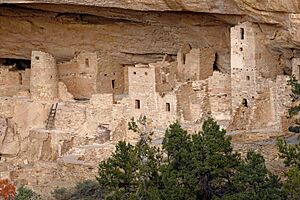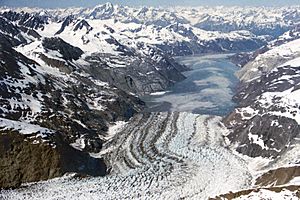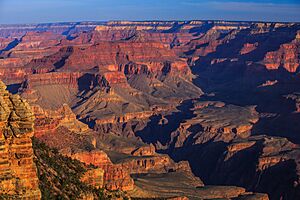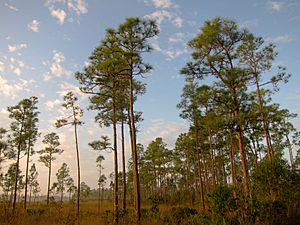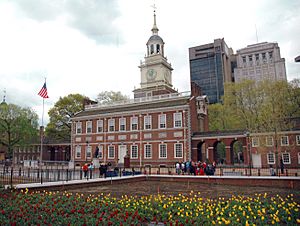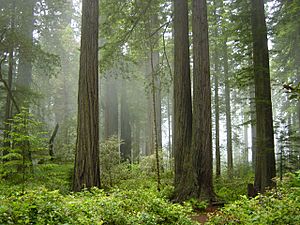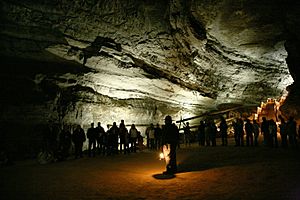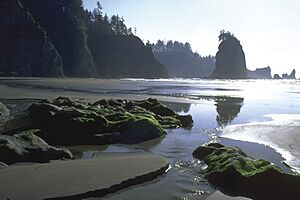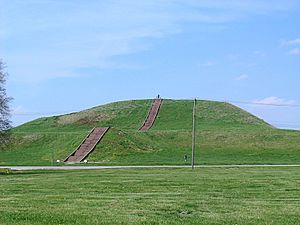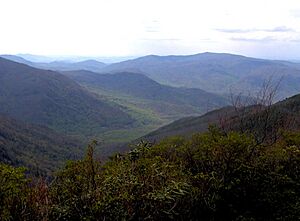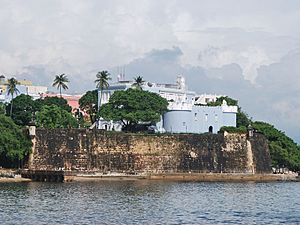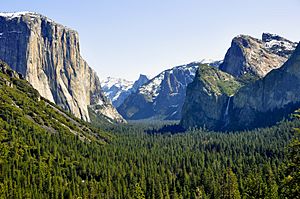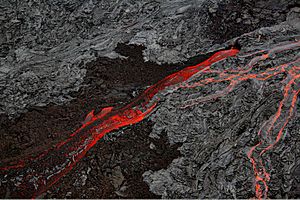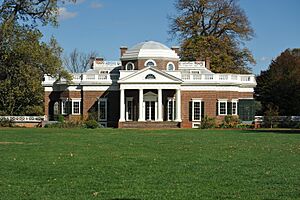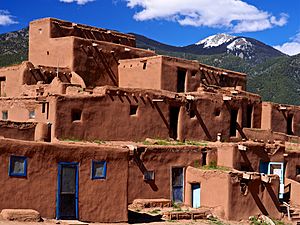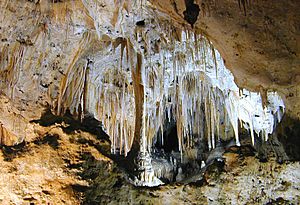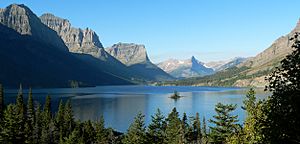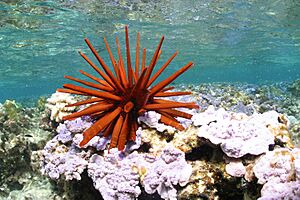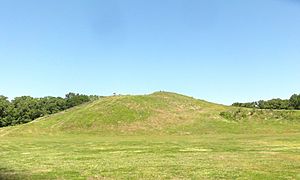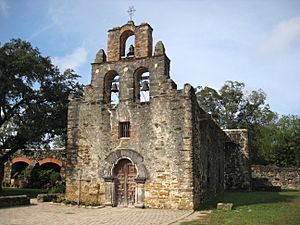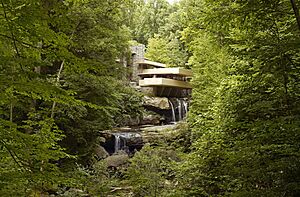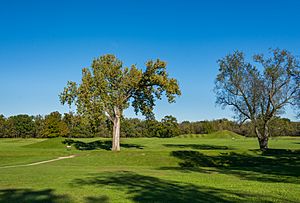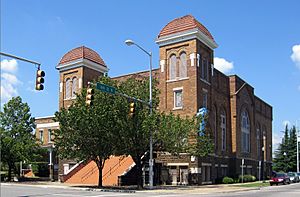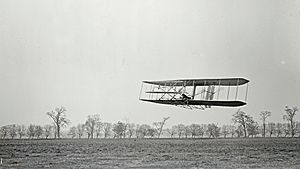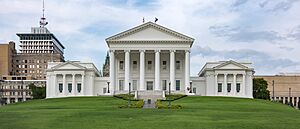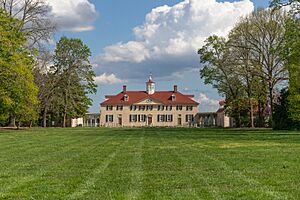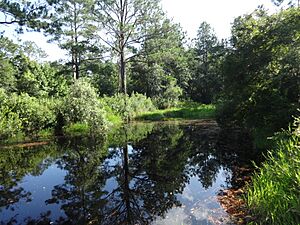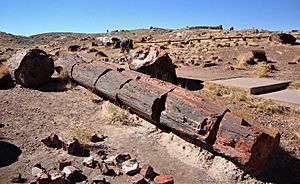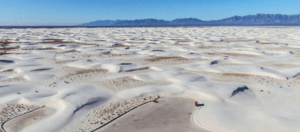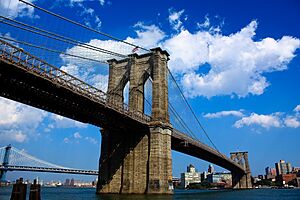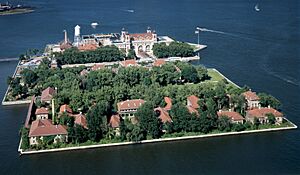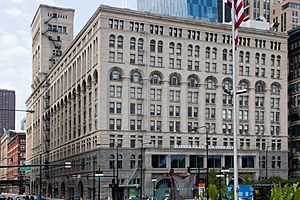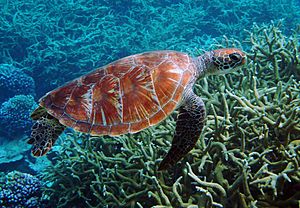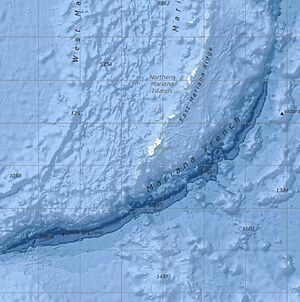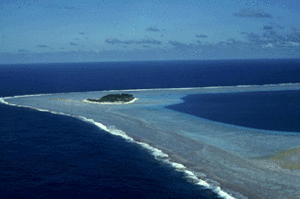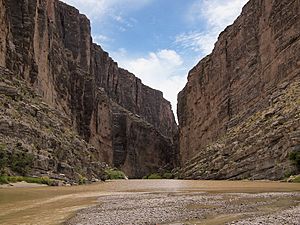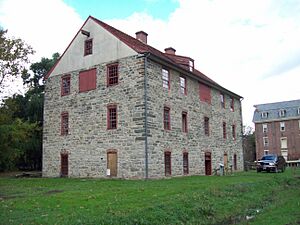List of World Heritage Sites in the United States facts for kids
The United Nations Educational, Scientific and Cultural Organization (UNESCO) helps protect amazing places around the world. These special spots are called World Heritage Sites. They are important because of their unique culture or incredible natural heritage.
Cultural heritage means things like old buildings, sculptures, or important historical places. Natural heritage includes beautiful landscapes, special rock formations, or homes for rare animals and plants.
The United States joined this effort in 1973. Today, there are 25 World Heritage Sites in the U.S. Plus, there are 18 more places that might become sites in the future!
The very first U.S. sites added to the list in 1978 were Mesa Verde National Park and Yellowstone National Park. The newest site, added in 2023, is the Hopewell Ceremonial Earthworks. These 25 sites are found in 22 different states and two U.S. territories. Some states like Arizona, California, and New York have more than one site. Two sites are even shared with Canada!
Out of the 25 sites, 12 are cultural, 12 are natural, and one, Papahānaumokuākea, is a mix of both. Sadly, one site, Everglades National Park, is currently listed as endangered. This means its amazing water systems are in trouble.
Contents
Amazing World Heritage Sites in the U.S.
UNESCO uses ten special rules to decide if a place can be a World Heritage Site. Each site must meet at least one of these rules. Rules 1 to 6 are for cultural sites, and rules 7 to 10 are for natural sites.
* Shared with another country ![]() In danger
In danger
| Site | Image | Location (state) | Year listed | UNESCO data | What Makes It Special |
|---|---|---|---|---|---|
| Mesa Verde National Park | Colorado | 1978 | 27; iii (cultural) | This park was home to the ancient Pueblo people between the 6th and 12th centuries. You can see over 4,000 old sites, including amazing cliff dwellings built right under cliffs. Some are small rooms, while others are huge complexes with over 100 rooms. Cliff Palace (pictured) is a great example. | |
| Yellowstone National Park | Wyoming, Montana, Idaho | 1978 | 28; vii, viii, ix, x (natural) | Yellowstone was the world's first national park, created in 1872! It's huge, covering almost 9,000 square kilometers (3,500 sq mi). It has more than 300 geysers, which are hot springs that shoot water and steam into the air. That's over half of all the geysers in the world! The park is also home to large herds of bison, grizzly bears, and gray wolves. | |
| Kluane / Wrangell–St. Elias / Glacier Bay / Tatshenshini-Alsek* | Alaska | 1979 | 72ter; vii, viii, ix, x (natural) | This huge area crosses the border between the U.S. and Canada. It has the world's largest non-polar ice field and many giant glaciers. It's a wild place with high mountains, coastal forests, and river valleys. You can find grizzly bears, caribou, and mountain goats here. Johns Hopkins Glacier (pictured) is one of its famous sights. | |
| Grand Canyon National Park | Arizona | 1979 | 75; vii, viii, ix, x (natural) | The Grand Canyon is a breathtaking gorge carved by the Colorado River over six million years. It's 277 miles (446 km) long and up to 18 miles (29 km) wide, reaching depths of 1.5 kilometers (0.93 mi)! The river has cut through rock layers that are 2 billion years old, showing Earth's long history. It's also home to many different animals and plants. | |
| Everglades National Park |
Florida | 1979 | 76; viii, ix, x (natural) | The Everglades is a huge, flat wetland with coastal and ocean areas. It has different habitats like mangrove forests and pine rocklands (pictured). It's a special home for animals like the manatee, Florida panther, alligator, and crocodile. This site is currently in danger because its water systems are being harmed. | |
| Independence Hall | Pennsylvania | 1979 | 78; vi (cultural) | This historic building was finished in 1753. It's where the Declaration of Independence was signed in 1776, declaring America's freedom. Later, the U.S. Constitution was debated and signed here in 1787. Both documents have inspired people around the world. | |
| Redwood National and State Parks | California | 1980 | 134; vii, ix (natural) | These parks along the northern California coast are home to the tallest trees on Earth: the coast redwoods. Imagine trees so tall they disappear into the fog! The park also has beautiful coastlines where you can see sea lions, bald eagles, and California brown pelicans. | |
| Mammoth Cave National Park | Kentucky | 1981 | 150; vii, viii, x (natural) | Mammoth Cave is the longest known cave system in the world! Over 426 miles (686 km) of its passages have been mapped. It's home to more than 130 different species that live only in caves. The area around the cave has many sinkholes and underground rivers. | |
| Olympic National Park | Washington | 1981 | 151; vii, ix (natural) | This park has many different environments, including the largest protected temperate rainforest in the region. It also has long stretches of wild Pacific coastline, high alpine meadows, and mountains covered with glaciers. Many unique animals and plants live here, like the northern spotted owl. | |
| Cahokia | Illinois | 1982 | 198; iii, iv (cultural) | Cahokia was the biggest and most important city of the Mississippian culture before Europeans arrived in North America. It was a bustling place between 1050 and 1150, with up to 20,000 people! The site has about 120 mounds, including Monks Mound (pictured), the largest prehistoric earthen structure in the Americas. | |
| Great Smoky Mountains National Park | North Carolina, Tennessee | 1983 | 259; vii, viii, ix, x (natural) | This park is a special place where many plants and animals from a very old era have survived. It's a "biodiversity hotspot," meaning it has a huge variety of life. It's home to over 3,500 plant species and many animals, including one of the world's largest varieties of salamanders. | |
| La Fortaleza and San Juan National Historic Site in Puerto Rico | Puerto Rico | 1983 | 266bis; vi (cultural) | These old forts and walls in Puerto Rico were built by Europeans from the 16th to 20th centuries to protect the city of San Juan. They show how military buildings changed over time and adapted to the Caribbean. La Fortaleza (pictured) is a beautiful example. | |
| Statue of Liberty | New York | 1984 | 307; i, vi (cultural) | The Statue of Liberty, opened in 1886, was a gift from France to celebrate 100 years of American independence. Designed by Frédéric Bartholdi and Gustave Eiffel, it was a marvel of engineering. Standing at the entrance to New York Harbor, it has welcomed millions of immigrants and symbolizes freedom and human rights. | |
| Yosemite National Park | California | 1984 | 308; vii, viii (natural) | Located in the Sierra Nevada mountains, Yosemite was shaped by ancient glaciers. These glaciers carved out amazing features like deep valleys, towering cliffs, and beautiful waterfalls. You can also find groves of giant Giant Sequoia trees here. The picture shows the famous Tunnel View of Yosemite Valley. | |
| Chaco Culture | New Mexico | 1987 | 353rev; iii (cultural) | Chaco Canyon was a major center for the Ancestral Puebloans between 850 and 1250. Even though the environment was harsh, this organized society built huge structures called "great houses." These buildings were used for living, storage, and ceremonies. The great kiva at Chetro Ketl is pictured. | |
| Hawaii Volcanoes National Park | Hawaii | 1987 | 409; viii (natural) | This park on the island of Hawaii is home to Kīlauea and Mauna Loa, two of the world's most active volcanoes. The park's landscape is constantly changing due to frequent volcanic eruptions. You can see amazing lava flows (pictured) and rare bird species here. | |
| Monticello and the University of Virginia in Charlottesville | Virginia | 1987 | 442bis; i, iv, vi (cultural) | Thomas Jefferson, who wrote the Declaration of Independence and was the third U.S. President, designed Monticello (pictured) as his home. He also designed the first buildings of the University of Virginia in Charlottesville. These buildings are great examples of neoclassical architecture, a style inspired by ancient Greek and Roman designs. | |
| Taos Pueblo | New Mexico | 1992 | 492; iv (cultural) | Taos Pueblo is the largest of the Pueblo settlements built in the late 1200s and early 1300s. It has been lived in continuously ever since! It's an important example of a culture that has kept most of its ancient traditions. The settlement has two multi-story adobe buildings (pictured) and ceremonial kivas. | |
| Carlsbad Caverns National Park | New Mexico | 1995 | 721; vii, viii (natural) | This park has over 100 karst caves, including the famous Carlsbad Caverns (interior pictured). These caves have amazing and rare speleothems, which are cave formations like stalactites and stalagmites. Some of these formations are even made with the help of bacteria! | |
| Waterton-Glacier International Peace Park* | Montana | 1995 | 354rev; vii, ix (natural) | This park is shared between Canada and the U.S. It's famous for its stunning mountains and landforms shaped by glaciers. It sits on the Continental Divide, where rivers flow to different oceans. The park has a huge number of animal and plant species in a small area. Saint Mary Lake is pictured. | |
| Papahānaumokuākea | Hawaii and United States Minor Outlying Islands | 2010 | 1326; iii, vi, viii, ix, x (mixed) | This is the world's largest marine protected area, located west of the main Hawaiian Islands. It covers many small islands, atolls, and the ocean around them. It's home to countless birds, fish, seals, corals, and plants, many of which are found nowhere else. The islands are also very important to Native Hawaiian culture. A sea urchin is pictured. | |
| Monumental Earthworks of Poverty Point | Louisiana | 2014 | 1435; iii (cultural) | The huge earthen structures at Poverty Point were built between 1700 and 1100 BCE. What's amazing is that they were created by a society of fishermen-hunter-gatherers, not settled farmers! The complex has semi-circular ridges and several mounds (pictured). It was also a center for a large trade network. | |
| San Antonio Missions | Texas | 2015 | 1466; ii (cultural) | This site includes five old mission complexes built in the 1700s by Spanish Franciscan missionaries. They were built along the San Antonio River to spread religion and protect the frontier. They show how Spanish and Native American cultures mixed. The churches have decorations that blend Catholic and native designs. Mission Espada is pictured. | |
| The 20th-Century Architecture of Frank Lloyd Wright | Arizona, California, Illinois, New York, Pennsylvania, Wisconsin | 2019 | 1496rev; ii (cultural) | This site includes eight buildings designed by the famous architect Frank Lloyd Wright. He created "organic architecture," where buildings fit perfectly with their surroundings and the needs of the people using them. His style used new materials like steel and concrete. Fallingwater (pictured), a house built over a waterfall, is one of these amazing buildings. | |
| Hopewell Ceremonial Earthworks | Ohio | 2023 | 1689; i, iii (cultural) | This site shows the incredible earthworks built by the Hopewell culture over 1,000 years ago. They created huge mounds and walls in geometric shapes for ceremonies. Hopewell Culture National Historical Park has five sites, including Mound City (pictured) with over 30 mounds. They also made beautiful objects from materials found far away, even near Yellowstone! |
Future World Heritage Sites: The Tentative List
Countries can suggest new sites to be added to the World Heritage List. These suggestions go on a "tentative list" first. Here are some of the places the United States is considering for the future:
| Site | Image | Location (state) | Year listed | UNESCO criteria | What Makes It Special |
|---|---|---|---|---|---|
| Civil Rights Movement Sites | Alabama | 2008 | vi (cultural) | This site includes three African-American churches that were very important in the Civil Rights Movement. This movement worked to end racial segregation and discrimination in the U.S. These churches show the peaceful fight for social change. The 16th Street Baptist Church (pictured) was partly rebuilt after a bombing in 1963. | |
| Dayton Aviation Sites | Ohio | 2008 | ii (cultural) | In 1904 and 1905, the Wright brothers tested their early airplanes here, including the Wright Flyer III, the world's first practical airplane! This nomination includes the Huffman Prairie flying field (pictured with an early flight), the Wright Cycle Company where they experimented, and other places related to their aviation breakthroughs. | |
| Thomas Jefferson Buildings | Virginia | 2008 | iii, vi (cultural) | This proposal would add two more buildings designed by Thomas Jefferson to the existing World Heritage Site. These are Poplar Forest, his plantation home, and the Virginia State Capitol in Richmond (pictured). Jefferson was very interested in designing homes, schools, and government buildings. | |
| Mount Vernon | Virginia | 2008 | iv (cultural) | Mount Vernon was the home and plantation of George Washington, the first president of the United States. The property has 16 buildings, including the mansion (pictured), servant houses, and stables. It's a well-preserved example of an 18th-century American South plantation. | |
| Serpent Mound | Ohio | 2008 | i, iii, iv (cultural) | The Serpent Mound is a huge earthwork shaped like a snake, built around 1120 CE. It's 411 meters (1,348 ft) long and up to 1.5 meters (4.9 ft) tall! It's the world's largest preserved prehistoric mound of its kind and shows the amazing earthworks built by ancient cultures in the Eastern U.S. | |
| Okefenokee National Wildlife Refuge | Georgia | 2008 | viii, ix, x (natural) | This wildlife refuge covers most of the Okefenokee Swamp, a huge wetland with untouched peat deposits. It's full of different plants and animals, including up to 1,000 species of moths! Unlike many wetlands, the Okefenokee is the source of two rivers, which helps keep it undisturbed. | |
| Petrified Forest National Park | Arizona | 2008 | vii, viii (natural) | This park is rich in fossils from the Late Triassic period. You can see many petrified trees (pictured), which are trees that have turned into stone over millions of years. Scientists study these fossils to learn about ancient ecosystems and even early dinosaurs! | |
| White Sands National Monument | New Mexico | 2008 | vii, viii (natural) | White Sands is a huge gypsum desert. It's the largest and best-protected natural gypsum deposit in the world. The area supports many unique animals and plants that have adapted to live in this harsh, beautiful environment of white dunes (pictured). | |
| Brooklyn Bridge | New York | 2017 | ii, iv (cultural) | The Brooklyn Bridge is a famous suspension bridge that connects Manhattan and Brooklyn in New York City. Finished in 1883, it was a huge step forward in bridge building, using new materials like steel cables. It's a symbol of the city and a monument to 19th-century engineering. | |
| Ellis Island | New York, New Jersey | 2017 | iv (cultural) | Ellis Island is a small island in New York Harbor that was the main entry point for millions of immigrants coming to the U.S. from Europe in the late 1800s and early 1900s. The main building now houses a museum about immigration. The picture shows an aerial view of the island and its many buildings. | |
| Central Park | New York | 2017 | i, ii, iv (cultural) | Central Park is a huge urban park in the middle of Manhattan. It was designed in the mid-1800s to give people in the growing city a place to enjoy nature. The park uses the natural landscape, with meadows, lakes, and woods. It's a beautiful example of landscape architecture. The Pond is pictured. | |
| Early Chicago Skyscrapers | Illinois | 2017 | i, iv (cultural) | This nomination includes nine buildings in Chicago that were among the very first "skyscrapers" in the world. Built in the late 1800s, these tall buildings used new ideas like steel frames and elevators. Architects also created new looks for these tall structures. The Auditorium Building (pictured) is one of them. | |
| Pacific Remote Islands Marine National Monument | United States Minor Outlying Islands | 2017 | vii, viii, x (natural) | This nomination covers seven islands and atolls south of Hawaii, along with the ocean around them. They have beautiful coral reefs and are home to many seabirds, fish, whales, and other sea creatures. Many deep-sea corals live on the underwater mountains here. A green sea turtle at Palmyra Atoll is pictured. | |
| California Current Conservation Complex | California | 2017 | vii, viii, ix, x (natural) | The California Current flows along the California coast, bringing nutrient-rich water to the surface. This creates a very productive ocean environment. The nomination includes six protected areas with many habitats like kelp forests and rocky shores. You can find whales, sea turtles, sea otters, and even great white sharks here. The Farallon Islands are pictured. | |
| Marianas Trench Marine National Monument | Northern Mariana Islands | 2017 | viii, ix, x (natural) | This nomination includes parts of the Mariana Trench, which has the world's second deepest point! It also has 21 underwater volcanoes and three northern Mariana Islands. This area is where one of Earth's plates slides under another, creating unique geological features. The islands have rich coral reefs, and the Trench is home to many unusual and undiscovered species. | |
| Marine Protected Areas of American Samoa | American Samoa | 2017 | vii, ix, x (natural) | This area has beautiful tropical coral reefs that are full of different kinds of life. Some of these corals have even shown they can recover from coral bleaching. There are also underwater mountains and hot vents that support deep-sea creatures. Rose Atoll (pictured) is an important safe place for giant clams. | |
| Big Bend National Park | Texas | 2017 | viii, ix (natural) | This park includes parts of the Chihuahuan Desert, mountains, and the area around the Rio Grande (a view at the Santa Elena Canyon pictured). It has desert plants and animals, and cooler mountains with ancient forests. The area is also rich in fossils from the last 130 million years, including the largest flying reptile ever found, the Quetzalcoatlus! | |
| Moravian Church Settlements (United States of America)* | Pennsylvania | 2022 | iii, iv (cultural) | These settlements of the Moravian Church, a Christian group, were planned cities from the 1700s. They show the community's idea of equality. They all have similar layouts with green spaces, a church, a cemetery, and houses for communal living. The proposed site includes the Historic Moravian Bethlehem District (the tannery building pictured) in the U.S., along with sites in Germany and the United Kingdom. |
Images for kids
See also
 In Spanish: Anexo:Patrimonio de la Humanidad en Estados Unidos para niños
In Spanish: Anexo:Patrimonio de la Humanidad en Estados Unidos para niños
- Tourism in the United States


